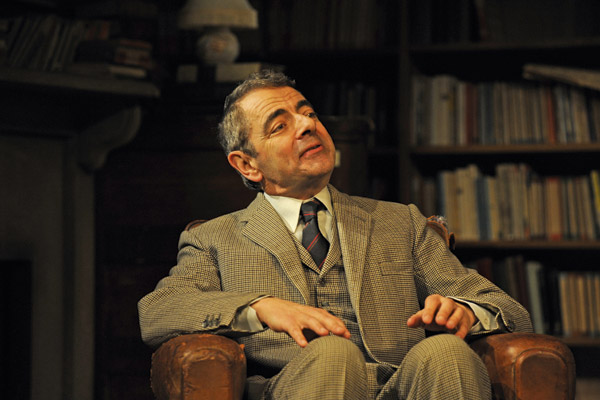Quartermaine’s Terms is a period piece within a period piece. It’s set in that part of the early 1960s which was still effectively the 1950s. St John Quartermaine, a shy bumbler, is the oldest and most useless teacher at a Cambridge language school. All his colleagues are lovable freaks. There’s the Jesus-worshipping spinster shackled to her ailing mum. There’s the caravanning dad who takes calamitous holidays in rain-swept Norfolk. There’s the wannabe novelist ditched by his wife while writing a particularly heartfelt chapter about marital bliss. And there’s the boss, a fogeyish queen, who has no idea the school is heading for the buffers. Each of these charming eccentrics arrives in the staffroom every day, like a penitent to the confessional, and unloads his or her sorrows in a neutral space. It’s an inspired plan.
Writer Simon Gray does more than illustrate the detachment of English people, and their fear of confrontation, he formally incorporates it in the play’s architecture. But this masterstroke also deprives the drama of a vital resource: significant real-time action. Nothing much happens in front of us and we end up feeling we’re in the warm-up arena rather than the Olympic stadium.
Quartermaine is a sweet-natured nerd in a three-piece suit who skulks at the fringes of the action and makes the odd clumsy attempt to involve himself in colleagues’ lives. He fails, of course. It’s a tragic role but without tragic lines or tragic deeds. A sense of inner coldness and bewildered reserve must be communicated by implication and suggestion. Rowan Atkinson, one of the world’s greatest mimes, responds by giving us the anxious, static grin that we’re familiar with. This goofy mask is ideal for an interfering butterfingers like Mr Bean or for an angry misfit like Blackadder. But it can’t hope to take us to the heart of Quartermaine’s inscrutable isolation.
The title role is a void into which the rest of the cast gleefully tumble. Will Keen brings plenty of narky bluster to Derek, an embittered part-timer, who has to moonlight as a postman to pay his bills. A splendidly crumpled Conleth Hill shows off all his tricks and grace notes as the governor’s overworked second-in-command. And that dusty actor, Malcolm Sinclair, performs wonders as Eddie, the bumbling and sonorous goon who runs the school. Poor Rowan Atkinson has to watch it all from Quartermaine’s motionless armchair. He must be wondering why everyone else is having such a ball. It’s hard to think of a play that captures the emotional caginess of educated English folk quite so exquisitely. But it’s a show that doesn’t move one in the slightest.
Old Times by Harold Pinter, staged at the theatre bearing his name, is set in a seaside town in the early 1970s. Deeley, a suave intellectual, and his zonked-out wife, Kate, are lounging around awaiting the arrival of Anna, a jabbering minx who shared digs with Kate 20 years earlier. Sexy Anna has come all the way from Sicily, apparently, to eat a lamb casserole. (The play is not a great advertisement for social life in the western Med.)
Her appearance triggers a tide of reminiscences about the trio’s intersecting lives in Soho in the early 1950s. We learn that Deeley had a dalliance with Anna after meeting her in a pub or at the cinema or at a party. Or maybe somewhere else. Or perhaps the entire affair is a figment of Deeley’s libidinous imagination. Pinter deliberately obscures the plotlines in order to make his point that memory, like history, is an artefact of the winners. An interesting thesis, I suppose, albeit of the yes-Harold-we-knew-that-already variety. The meandering dialogue teems with romantic uncertainty as the three rivals circle each other and exchange mundanities that conceal jealousy and aggression. By the end, something has happened. Or perhaps it hasn’t. Kate has a bath. Anna has a lie-down. Deeley blubs. Not sure why. Sorry for himself, perhaps. But don’t bet on it.
Critics seem united in the view that this is a peerless version of one of the greatest achievements in the dramatic repertoire. I was seated near several play-goers who didn’t quite see it in that exalted fashion. They didn’t see it at all. They were asleep. Lucky them. This is a befuddled, rambling and self-satisfied sliver of poppycock, which must rank as one of the dreariest productions currently on show in the capital. And there’s more bad news. Seats are still available! So if you were hoping to plead ‘house full’ as your excuse, you’re out of luck. But cheer up. It’s only 90 minutes and you’ll feel a lot better afterwards.







Comments